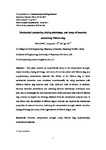Mechanical properties, drying shrinkage, and creep of concrete containing lithium slag
| dc.contributor.author | Li, Long-yuan | |
| dc.date.accessioned | 2017-04-25T09:31:14Z | |
| dc.date.available | 2017-04-25T09:31:14Z | |
| dc.date.issued | 2017-04-24 | |
| dc.identifier.issn | 0950-0618 | |
| dc.identifier.issn | 1879-0526 | |
| dc.identifier.uri | http://hdl.handle.net/10026.1/9115 | |
| dc.description.abstract |
This paper presents an experimental study on the compressive strength, elastic modulus, drying shrinkage, and creep of concrete added with lithium slag as a supplementary cementitious material. The effects of the lithium slag on these mechanical properties were examined experimentally by using specimens with different lithium slag contents (0%, 10%, 20% and 30% of binder). In addition, mercury intrusion porosimetry and scanning electron microscope techniques were also used to investigate the pore microstructure of the concretes with different lithium slag contents to support the findings obtained from the mechanical property tests. It was shown that, the addition of lithium slag in concrete can improve the mechanical properties of matured concrete, including the compressive strength, elastic modulus, drying shrinkage and creep, if the right amount of lithium slag is used. | |
| dc.format.extent | 296-304 | |
| dc.language | en | |
| dc.language.iso | en | |
| dc.publisher | Elsevier BV | |
| dc.subject | Concrete | |
| dc.subject | Compressive strength | |
| dc.subject | Creep | |
| dc.subject | Lithium slag | |
| dc.subject | Supplementary cementitious material | |
| dc.title | Mechanical properties, drying shrinkage, and creep of concrete containing lithium slag | |
| dc.type | journal-article | |
| dc.type | Journal Article | |
| plymouth.author-url | https://www.webofscience.com/api/gateway?GWVersion=2&SrcApp=PARTNER_APP&SrcAuth=LinksAMR&KeyUT=WOS:000403854100028&DestLinkType=FullRecord&DestApp=ALL_WOS&UsrCustomerID=11bb513d99f797142bcfeffcc58ea008 | |
| plymouth.volume | 147 | |
| plymouth.publication-status | Published | |
| plymouth.journal | Construction and Building Materials | |
| dc.identifier.doi | 10.1016/j.conbuildmat.2017.04.166 | |
| plymouth.organisational-group | /Plymouth | |
| plymouth.organisational-group | /Plymouth/Faculty of Science and Engineering | |
| plymouth.organisational-group | /Plymouth/Faculty of Science and Engineering/School of Engineering, Computing and Mathematics | |
| plymouth.organisational-group | /Plymouth/REF 2021 Researchers by UoA | |
| plymouth.organisational-group | /Plymouth/REF 2021 Researchers by UoA/UoA12 Engineering | |
| plymouth.organisational-group | /Plymouth/Research Groups | |
| plymouth.organisational-group | /Plymouth/Research Groups/Marine Institute | |
| plymouth.organisational-group | /Plymouth/Users by role | |
| plymouth.organisational-group | /Plymouth/Users by role/Academics | |
| dcterms.dateAccepted | 2017-04-18 | |
| dc.rights.embargodate | 2018-4-24 | |
| dc.identifier.eissn | 1879-0526 | |
| dc.rights.embargoperiod | Not known | |
| rioxxterms.versionofrecord | 10.1016/j.conbuildmat.2017.04.166 | |
| rioxxterms.licenseref.uri | http://www.rioxx.net/licenses/all-rights-reserved | |
| rioxxterms.licenseref.startdate | 2017-04-24 | |
| rioxxterms.type | Journal Article/Review |


